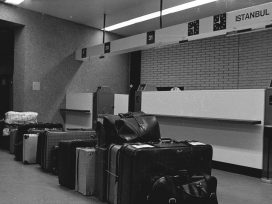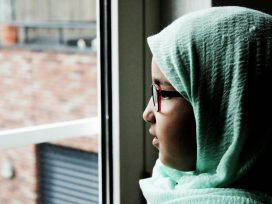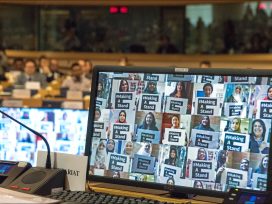On 5 February 1997, something happened in Yining, a small border town in northwest China. There was definitely a march, possibly a riot, maybe even a massacre. There were certainly shootings, injuries and deaths.
When you finally reach Yining, after two days on a train from Beijing, then another day on a bus, you will see the same broad streets lined with twostorey, white-tiled buildings that exist in every town in China. You can buy the same pirate DVDs, engine parts, strips of beef suffocated in plastic as you would elsewhere. You will recognise the men with short black hair in blue or black cheap suits, one hand hovering close to their pager, the other holding a cigarette of almost prohibitive strength. There will be overcrowded buses, red taxis with their fare lights on, men and women squatting, waiting, cracking sunflower seeds. Never mind that the sky’s unusually blue, that once, between a gap in the buildings, you glimpse a line of white-toothed mountains. By the time you reach the town square you will have forgotten that Kazakhstan is less than an hour away.
There is a sense of transition as you cross the square. As you reach the far side you see a line of market stalls selling carpets, brightly coloured scarves, packs of henna, crystal sugar, apricots, dried grapes, rubber-bunged medicine bottles of pomegranate juice. The heads are covered by scarves and twenty kinds of hat: homburgs, trilbies, pork pies, stiffened black skullcaps. The faces are… what are the faces? They could be Turkish, Russian, Iranian, British, but they are definitely not Chinese. The same is true of the language they’re speaking; you pass a stall of books whose titles are written in curling Arabic script.
As you round the corner you see both mosques: first the small one with a painted entrance, then the larger one with a towering minaret that ends in a gold spike. You stand and look at the great swelling dome, at the horse and carts that jingle by, and then you continue, down smaller streets that are unpaved, past low houses with cyan walls, turquoise doors, decorated shutters. Clay ovens are baking bread; old men slam chess pieces down; a flock of sheep flow through. You walk and breathe and feel confused. This no longer seems like China. This somehow does not fit.
When we say that someone or something is “Chinese”, we are usually conflating two different things: nationality and ethnicity. China’s main ethnic group, the Han, make up about 91 per cent of the population. Most of our knowledge about China – its food, culture, traditions and language – relates to the Han. So when we say that something or someone is Chinese, that thing or person is usually from China and of Han origin.
There are, however, fifty-five other ethnic groups spread throughout the country, some in sufficient demographic density that the Chinese government recognise the area as an “autonomous region”. Yining is located in the northwest corner of the Xinjiang Uighur Autonomous Region, a region three times the size of France, whose borders are defined by mountains: the Himalayas and Pamirs to the south, the Altai mountains to the north. The south of the province consists of the Taklamakan Desert, a vast area of sand and gravel that may contain more oil and gas than Saudi Arabia.
The main ethnic group in Xinjiang are the Uighurs (pronounced weegers), a Turkic people, which means that they belong to the same group of peoples who began in Central Asia and then eventually spread as far as Turkey. Their language is similar to Kazakh and Uzbek. Although many speak Mandarin Chinese, few are able to read and write Chinese with any great proficiency. The majority of Uighurs are Sunni Muslims, though there are considerable differences between religious practices in the north and south of the province, with the latter tending to be more orthodox.
Before 1949 (when the People’s Republic of China was founded), there were only 20,000 Han in the region, less than 5 per cent of the population. In Yining there were so few Han that a street was named Han Ren Jie (“the street of Han people”).
The succeeding years witnessed a demographic explosion, as the government encouraged Han from the more populated provinces to resettle in the region. Many of these are part of the Xinjiang Production & Construction Corps (XPCC). The XPCC was created in the early 1950s as a way to utilise soldiers from the surrendered Nationalist army. Since then successive waves of migration have swelled the ranks of the XPCC, which today stands at around 2.5 million.
The XPCC has its own police force, courts, agricultural and industrial enterprises, as well as its own large network of labour camps and prisons. Its main unit of production is the state farm or bingtuan. The bingtuans have had the dual function of developing the region’s economy and quelling unrest; in one of its marching songs it describes itself as “an army with no uniforms”. Many towns with a Uighur majority are now encircled by bingtuans.
The most noticeable aspect of life in Yining is how Han and Uighurs live separately. They eat in different restaurants (Uighurs only eat in halal establishments, whereas pork is an essential ingredient in Han cuisine); their children go to separate schools; they rarely socialise; they virtually never marry. The only time I ever saw Han and Uighurs happily together was at a cockfight.
They are even divided temporally: the Han run on Beijing time, whereas most Uighurs use Xinjiang time, which is two hours ahead (and more accurately reflects the position of the sun). For anyone who hopes to have Han and Uighur friends, this makes arranging any kind of meeting incredibly tiresome. You will frequently be two hours early, or late, even when you think you have specified whether the time of meeting is Xinjiang or Beijing shi dian. For many Uighurs, this imposition of the wrong time zone is more than simply absurd. It sums up the arrogance and indifference of the Chinese government to the fact that Xinjiang is so markedly different to the rest of China. You could almost be forgiven for thinking it was a separate country.
The Chinese government’s position on the history of Xinjiang is admirably clear. In essence, it amounts to:
One thing cannot be denied. Xinjiang has always been a part of China. Since the time of its origins, our great motherland has always been a multi-ethnic nation.
The position of some Uighurs is similarly clear:
One thing cannot be denied. Xinjiang has never been a part of China. Only in recent years have we become a Chinese colony.
The latter argue that “Xinjiang” should instead be recognised as the East Turkestan Republic, a name that refers to when the area was a republic in the mid-1940s. It is tempting to draw a parallel with Tibet; in both cases, the Han can be viewed as invaders, seeking to conquer and control a large population with its own pre-existing culture, customs, and, not least, religion.
However, even a brief study of Tibet’s history suggests a far more complicated relationship, one where the Han fade in and out, sometimes playing the aggressors, at other times, absent and fragmented neighbours, who were themselves invaded by the Tibetans on several occasions.
The history of Xinjiang is similarly complex. The idea of the region as a single unified area dates back no further than the middle of the eighteenth century. The region has usually consisted of several disparate kingdoms and rulers; only rarely has it been united under any one authority.
There has certainly been a Han presence throughout much of the region’s history. The first recorded contact was in the first century BC, when the Emperor sent an envoy in the hope of uniting its tribes against the invading Huns. The Han court later established an administrative centre in Xinjiang between 73 and 97 AD. Xinjiang remained under their control until the fifth Century, when it was conquered by Turkic tribes. During the Tang Dynasty, it was recovered but after their demise it remained out of Chinese control until 1750, when it was retaken by the Qing, who renamed the region “Xinjiang” (“new territory”). Unfortunately this did not inspire people to go there. Most viewed it as a terrible, backward place, where one was sent as a punishment. This view was so widespread that one of the emperors had to resort to paying people to go there. Only after 1949 was the region integrated into the rest of China; then there began to be talk of “developing the west”.
There is a long history of protest against Chinese rule. In 1962, 60,000 Uighur fled to the Soviet Union to escape famine and Mao’s Great Leap Forward. In the 1980s there were student demonstrations and riots, culminating in a bombing in Kashgar in 1989, and then, in 1990, a full-scale uprising in the southern town of Baren.
Hundreds of villagers protested in front of local government offices over birth control policies. Although the government allow minorities to have two children (compared to the one child that the Han are allowed), Uighurs traditionally have much larger families and thus resent the imposition of penalties (fines, confiscation of land) that result from them having more than two children. Officially, twenty-two died during a “counter-revolutionary rebellion”, including seven police officers. Amnesty International cites reports that more than fifty villagers were killed by mortar and helicopter gunship, most while they were running away. The government later blamed the riot on “ethnic separatists”, who, “cloaked in religion”, managed to deceive some people into taking part “in their plot to destroy national unity”.
Whilst there may have been a religious element to these protests, it is also true that the economic situation of Uighurs worsened in the early 1990s. 75 per cent of them are involved in husbandry or farming, especially cotton production. From 1991, many former Soviet countries started selling their cotton cheaply on the world market, undercutting Chinese prices. Previously the government had subsidised farmers’ losses, but this policy abruptly ended. Resentment was also directed against the bingtuans, which were accused of taking the best land.
There were further bombings, in Ürümqi (the provincial capital) in 1992, in Kashgar in 1993 and then, in 1995, a riot in Hotan. But it was in Yining, in 1997, that the largest protest took place. There are many versions of what happened on 5 February 1997, but all more or less agree on the following. A thousand Uighurs, most of them young and male, marched through the streets. They shouted slogans and destroyed property, and there were attacks on Han Chinese. When the marchers clashed with the police, there were numerous injuries and deaths.
Most foreign news agencies chose to portray this as a political protest. An Associated Press report described the events as “a Muslim march demanding independence”; Reuters described it as “a separatist riot”; CNN called it a “protest against Beijing rule”. But there was no shortage of alternative explanations. The East Turkestan Information Centre described it as “a peaceful demonstration demanding respect for human rights”. Official sources later claimed that it was nothing more than random violence, the work of “social garbage” such as thieves and drug addicts. They claimed there had been few casualties, but other accounts put the death toll as high as 400, alleging that soldiers had opened fire on the crowd. It was also claimed that some of the protestors had taken off their clothes and shouted, “Don’t sleep! Don’t eat! Don’t work!”
During the next few weeks a full-scale curfew was imposed in Yining and Ürümqi. There were extensive house-to-house searches and many arrests. According to Amnesty International, between 3,000 and 5,000 people were arrested, so many that all the places of detention in Yining were full. Those arrested were held without charge and there were many reports of torture.
On 24 April a rally was held in Yining city stadium, in order to pronounce sentence against thirty Uighurs who had taken part in the protests. Three men were sentenced to death on charges of “causing injury, arson, hooliganism, smashing property and looting”. They were put to death, immediately after the rally, at an execution ground on the outskirts of the city. According to unofficial sources, their bodies were not given back to their families.
Afterwards, the twenty-seven prisoners who had received prison sentences were driven through the city streets in an open convoy. A crowd consisting of relatives and friends approached the trucks, perhaps to say a few words to the prisoners, perhaps to try and rescue them. The police escort opened fire, reportedly killing three people and injuring ten others.
By June, the authorities had begun to link separatist activities with religion. The Xinjiang Daily reported that a crackdown on underground religious activities had resulted in an official banning of the construction or renovation of 133 mosques. Altogether forty-four “core participants in illegal religious activities” had been arrested in the region. Although freedom of religious belief is part of China’s constitution, there are many restrictions on where and how people are allowed to worship. Services and religious instruction are only permitted in specific, licensed venues, and the contents of all prayer meetings are closely scrutinised.
The executions continued. In April 1999, Amnesty International reported that since January 1997, there had been 210 death sentences, 190 of which had been carried out.
But eventually, slowly, often brutally, things began to settle down. The official rhetoric softened to the point where it sounded almost tolerant:
We have to take the endurance of the various ethnic groups into consideration. We [the Party] should respect the language as well as the customs and habits of different ethnic groups.
On 1 September 2001, Wang Lequan – Secretary of the Xinjiang Communist Party Committee – made the confident assertion that “Xinjiang is not a place of terror’ and was by no means ‘a place where violence and terrorist accidents take place very often.”
Ten days later, everything changed.
After two planes hit the World Trade Centre, someone in the Chinese government must have remembered all the “terrorist accidents” that weren’t happening. In October 2001 officials began talking about close ties between Xinjiang separatists and international terrorist forces, in effect suggesting that “separatism” was a form of “terrorism”.
The arrests began again. Seven Uighurs were executed for ‘disrupting social order’ in the week leading up to the country’s October holiday. The China News Service reported that police in Ürümqi had begun a “campaign to clear up cases”. Its aim, according to Du Jianxi, Ürümqi’s Public Security Bureau Chief, was to maintain “public order and stability by smashing the bloated pride of violent terrorists”.
On 14 November, Foreign Ministry spokesman Zhu Bangzao gave a press briefing on Uighur separatism. He listed ten organisations based in Afghanistan, elsewhere in Central Asia, or in Xinjiang, that he said were fighting to end Chinese rule. He argued that some Xinjiang separatists had received training in Afghanistan before being sent to China, and that the East Turkestan Islamic Movement (ETIM) was in fact supported and directed by Osama bin Laden. It was claimed that Hasan Mahsum, the leader of the ETIM, had met with bin Laden in 1999 and 2001, and received promises of “an enormous sum of money”. Bin Laden’s aim was apparently to launch a “holy war” to set up a theocratic Islamic state in Xinjiang.
The Yining riots were suddenly no longer the work of “social garbage” and other criminal elements. In January 2002, the People’s Daily described it as a “serious riot” perpetrated by the East Turkestan Islamic Party of Allah, during which “the terrorists shouted slogans calling for the establishment of an Islamic kingdom”.
Whilst this was all very topical, not to say convenient, there was little direct evidence for any links between al-Qaeda and Uighur separatists. Although there was undoubtedly a religious element to the Yining riots, it had little to do with fundamentalist Islam.
After the economic reforms of the 1990s (during which many state-owned factories and business were closed), there were high unemployment levels throughout Xinjiang. This led to a climate of despondency, in which some Uighur men began drinking heavily and using drugs. In an attempt to counteract this, Uighur men began to meet for a ritual known as a mäshräp. A mäshräp is many things. It is a forum for riddles, joke telling and music. It is also a means of regulating social behaviour and transmitting cultural and religious practices from one generation to another. One account of a mäshräp describes someone accusing his neighbour Abdul of drinking vodka at a birthday party. The judge explains that this is harmful to the health, a waste of money, and contrary to a Muslim’s submission to God. For all the apparent formality of a mäshräp, the ritual has no legal status, which is reflected in the type of “sentence” passed:
The judge proclaimed that the man would have to “go fishing in the lake”… The saqchi [guard] left the room and returned with a basin of water, a towel and three pieces of hard candy. The candies were placed in the water and [Abdul] was forced to get the candy out of the basin with his mouth. Several times, he fell face first into the water, and all the men in the room erupted into laughter. Each time, the saqchi would wipe his face off with the towel and taunt Abdul, asking him if he would like a drink of vodka now.
The aim of such embarrassment is to make the “guilty” renounce their transgression and promise to behave better. It is also supposed to dissuade others from committing similar “crimes”. Despite the clear religious component, the tone of the proceedings is quite unlike the strictness one might associate with a more fundamentalist version of Islam. The cultural component of the mäshräp – the songs and stories – is as important as the religious elements.
The first of the new mäshräps were held in Yining in 1994 and later spread as far as Ürümqi. Initially, the mäshräps met with the agreement of the city authorities. By the spring of 1995, it was estimated that there were up to 10,000 young men participating.
The authorities must have been alarmed by the level of participation: in general, the government is suspicious of any large-scale movement (e.g. the Falun Gong), which could potentially become a rallying point for dissent. When, in April 1995, the mäshräps in the Yining region elected a leader – Abdulhelil, a 28-year-old businessman with three children – they decided to act. The authorities banned the mäshräps, denouncing them as havens of separatist ideas. This led to considerable resentment, and many tried to continue the mäshräps secretly. In response, the police arrested many young men, some of whom were later released, while others were either never seen again, or their bodies were found in the countryside. Tensions between Han and Uighur increased until, in January 1997, some of the fathers of the missing gathered in the town square and demanded to know where their sons were. The police arrested them. Anxious that they would also disappear, people went to the police station and asked to see them but the police refused. The crowd grew. A soldier panicked and began shooting. This was when the riots began.
The riots were thus the result of numerous grievances: unemployment; religious repression; the wish for independence. In the wake of the Chinese government’s rebranding of separatism as “terrorism”, the situation of many Uighurs has worsened. According to Amnesty International, there have been more arrests and religious freedom has declined even further. In Yining, any Uighur who works in a state-run institution (such as a school, hospital, or post office) is strongly discouraged from displaying any signs of faith, especially fasting and praying during Ramadan. Imams have been required to attend political meetings; Uighur children are told in school that religion is “only superstition”.
These measures have only increased tensions between Han and Uighurs (it has also had the unintended effect of making some previously non-religious Uighurs into devout Muslims). But despite the resentment between the two communities, there have been few reported incidents of protest, violent or otherwise. One reason for this is the overwhelming military strength of the Chinese, and the swiftness with which any expressions of dissent are quashed. Another is the lack of a prominent figure, such as the Dalai Lama, to unite around. In order for the region to have any chance of real autonomy, let alone independence, either the Uighurs would have to vastly increase in organisation and strength, (something that the Chinese, in the wake of the mäshräps are unlikely to allow) or the Chinese government would have to weaken considerably its grip on the region. Both options, it must be said, seem very fragile hopes.
Sources and further reading
Amnesty International http://www.amnesty.org
Human Rights Watch http://china.hrw.org
Roberts, S. (1998) “Negotiating Locality, Islam, and National Culture in a Changing Borderlands: The Revival of the Mäshräp Ritual Among Young Uyghur Men in the Ili Valley”. Central Asian Survey 17. (See quote p.50.)
Rudelson, J.J. (1998) Oasis Identities: Uyghur Nationalism Along China’s Silk Road, Columbia University Press: New York.
Tyler, C. (2003) Wild West China: The Taming of Xinjiang, John Murray: London.





